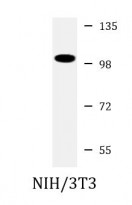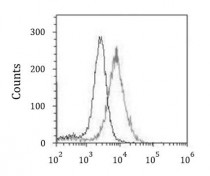ARG40474
anti-MCM3 antibody
anti-MCM3 antibody for Flow cytometry,Western blot and Human,Mouse,Rat,Hamster
Overview
| Product Description | Mouse Monoclonal antibody recognizes MCM3 |
|---|---|
| Tested Reactivity | Hu, Ms, Rat, Hm |
| Tested Application | FACS, WB |
| Host | Mouse |
| Clonality | Monoclonal |
| Clone | 1593CT377.41.73 |
| Isotype | IgG1, kappa |
| Target Name | MCM3 |
| Antigen Species | Human |
| Immunogen | Recombinant protein of Human MCM3. |
| Conjugation | Un-conjugated |
| Alternate Names | DNA polymerase alpha holoenzyme-associated protein P1; RLF subunit beta; P1.h; HCC5; DNA replication licensing factor MCM3; p102; EC 3.6.4.12; P1-MCM3; RLFB |
Application Instructions
| Application Suggestion |
|
||||||
|---|---|---|---|---|---|---|---|
| Application Note | * The dilutions indicate recommended starting dilutions and the optimal dilutions or concentrations should be determined by the scientist. | ||||||
| Positive Control | NIH/3T3 | ||||||
| Observed Size | ~ 100 kDa |
Properties
| Form | Liquid |
|---|---|
| Purification | Purification with Protein G. |
| Buffer | PBS and 0.09% (W/V) Sodium azide. |
| Preservative | 0.09% (W/V) Sodium azide. |
| Storage Instruction | For continuous use, store undiluted antibody at 2-8°C for up to a week. For long-term storage, aliquot and store at -20°C or below. Storage in frost free freezers is not recommended. Avoid repeated freeze/thaw cycles. Suggest spin the vial prior to opening. The antibody solution should be gently mixed before use. |
| Note | For laboratory research only, not for drug, diagnostic or other use. |
Bioinformation
| Database Links |
Swiss-port # P25205 Human DNA replication licensing factor MCM3 Swiss-port # P25206 Mouse DNA replication licensing factor MCM3 |
|---|---|
| Gene Symbol | MCM3 |
| Gene Full Name | minichromosome maintenance complex component 3 |
| Background | The protein encoded by this gene is one of the highly conserved mini-chromosome maintenance proteins (MCM) that are involved in the initiation of eukaryotic genome replication. The hexameric protein complex formed by MCM proteins is a key component of the pre-replication complex (pre_RC) and may be involved in the formation of replication forks and in the recruitment of other DNA replication related proteins. This protein is a subunit of the protein complex that consists of MCM2-7. It has been shown to interact directly with MCM5/CDC46. This protein also interacts with and is acetylated by MCM3AP, a chromatin-associated acetyltransferase. The acetylation of this protein inhibits the initiation of DNA replication and cell cycle progression. Two transcript variants encoding different isoforms have been found for this gene. [provided by RefSeq, Jul 2012] |
| Function | Acts as component of the MCM2-7 complex (MCM complex) which is the putative replicative helicase essential for 'once per cell cycle' DNA replication initiation and elongation in eukaryotic cells. The active ATPase sites in the MCM2-7 ring are formed through the interaction surfaces of two neighboring subunits such that a critical structure of a conserved arginine finger motif is provided in trans relative to the ATP-binding site of the Walker A box of the adjacent subunit. The six ATPase active sites, however, are likely to contribute differentially to the complex helicase activity. Required for DNA replication and cell proliferation. [UniProt] |
| Cellular Localization | Nucleus. [UniProt] |
| Calculated MW | 91 kDa |
| PTM | O-glycosylated (O-GlcNAcylated), in a cell cycle-dependent manner. [UniProt] |
Images (2) Click the Picture to Zoom In
-
ARG40474 anti-MCM3 antibody WB image
Western blot: 20 µg of NIH/3T3 whole cell lysate stained with ARG40474 anti-MCM3 antibody at 1:4000 dilution.
-
ARG40474 anti-MCM3 antibody FACS image
Flow Cytometry: HeLa cells were fixed with 2% paraformaldehyde (10 min) and then permeabilized with 90% methanol for 10 min. The cells were then incubated in 2% BSA to block non-specific protein-protein interactions followed by ARG40474 anti-MCM3 antibody (right histogram) at 1:25, 60 min at 37°C, followed by incubation with DyLight®488 labelled secondary antibody. Isotype control antibody (left histogram) was Mouse IgG1 (1 µg/10^6 cells) used under the same conditions. Acquisition of > 10000 events was performed.







